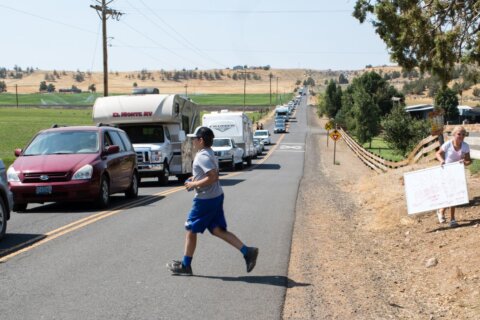
A piece of Interstate 66 toll money could be the key to major Metro and Virginia Railway Express improvements.
Virginia officials and the Northern Virginia Transportation Commission are in the final stages of negotiations to dedicate a portion of toll revenue to construction of a new Metro station or tunnel(s) near Rosslyn and the construction of a second Long Bridge freight and commuter rail span between Virginia and D.C.
Those improvements would help add significantly better options for commuters and, along with newly planned commuter bus services, could drive millions more trips on transit each year, according to Virginia Department of Rail and Public Transportation forecasts.
The change for the use of I-66 inside the Capital Beltway toll revenue would allow Virginia to sell bonds to help pay for the construction of the rail projects. Low-interest federal transportation loans could be used to finance construction.
The agreement would not change toll prices.
At least $10 million per year in toll revenues would remain reserved for other improvements along the corridor like additional commuter bus services.
State and Northern Virginia leaders had been close to approving a similar agreement shortly after tolls launched in 2017, but that effort was then paused until tolling operations settled in.
The exact amount of bonding and toll revenue available would be dependent on potential changes to tolling rules.
Drivers are expected to need to be HOV-3+ to avoid the rush-hour toll starting in 2022 or 2023, and the potential remains to impose tolls in the off-peak direction at rush hour as was originally planned.
New bridge likely to come first
The Long Bridge is farther along in the planning process than any additional Metro expansion.
Virginia recently took over efforts to get the bridge built from the District Department of Transportation following the initial environmental reviews.
Adding the planned second two-track span between Arlington and D.C. for Amtrak and Virginia Railway Express service is the only way to add more passenger trains along the Manassas and Fredericksburg lines. The tracks including the current aging two-track bridge are controlled by freight railroads CSX and Norfolk Southern. The state also is paying for other additional tracks in the area.
“We’re seeing the potential for ridership on the Manassas Line to double, reducing traffic on I-66,” Chief of Public Transportation Jennifer DeBruhl said.
Virginia also has a new plan for commuter buses in the I-66 corridor over the next decade with additional service between areas including Manassas and Tysons, Reston, Ballston and downtown D.C.
Combined, the draft plans for outside the Beltway service are projected to lead to a total of 3.7 million commuter bus riders and about 4.1 million VRE Manassas Line riders per year along the I-66 corridor by 2030.
The ridership boosts are on top of Orange and Silver Line Metro and local bus ridership and could help prevent traffic jams from quickly returning to Interstate 66 after the toll lanes under construction between the Beltway and Gainesville open around 2022.
“It’s a game changer that we have by optimizing the different options that we have available and by being able to include VRE as part of that slate of options,” DeBruhl said.
Virginia plans to lead a similar study of potential transit routes over the Legion Bridge as part of plans to extend Beltway toll lanes. That study could start this winter.
“We’re looking for multimodal solutions,” Virginia Transportation Secretary Shannon Valentine said.
New Metro station, lines part of long-term vision
Earlier this month, Metro revealed its “preliminary concepts” for major changes on the Blue, Orange and Silver Lines that could be partially funded through the newly identified revenue or related bonds.
The plans are in line with the initial details provided in June based on a number of previous high-level planning efforts.
While any major construction would likely be anywhere from five years to 25 years from now, here are the proposals:
- Turn trains around in the middle of the Orange, Silver or Blue lines at locations like West Falls Church, East Falls Church, Ballston, Rosslyn or Stadium-Armory using new platforms or crossovers for trains to move between tracks;
- Build a new platform at Rosslyn to separate the Blue Line tracks so that trains either run only between Franconia-Springfield and Rosslyn or link that station to Court House so that some Silver Line trains could turn south toward Pentagon;
- Build a new Blue Line platform at Rosslyn and extend those separate tracks either through Georgetown up Wisconsin Avenue NW to Friendship Heights/Bethesda or extend the tracks east through the Dupont Circle, Convention Center and Union Station areas;
- Build a long suggested Blue/Yellow Line loop through downtown and a new separated Rosslyn platform. The loop would go through Georgetown, Dupont, Shaw, Union Station and Navy Yard;
- Build an entirely new set of tracks for the Silver Line. Options include tracks from McLean or West Falls Church to Bethesda or Friendship Heights and across the northern part of D.C. to Prince Georges County; tracks that go more toward Georgetown and downtown D.C.; or tracks that go south from West Falls Church along Virginia Route 7 and east along Columbia Pike to Pentagon where trains could either turn south toward Reagan National or north; toward L’Enfant Plaza for new service through Southeast D.C. and Prince George’s County
- Simply make current service better with trains that have more room to stand, more locations where trains can cross between tracks to avoid delays, easier access to stations and more space for riders at existing stations, and improvements to bus service that provides alternatives to the train.
The final public meeting in this round of input on Metro’s proposals is scheduled from 4:30 p.m. to 7:30 p.m. Tuesday at the Courtyard by Marriott Tysons McLean at 1960A Chain Bridge Road.







